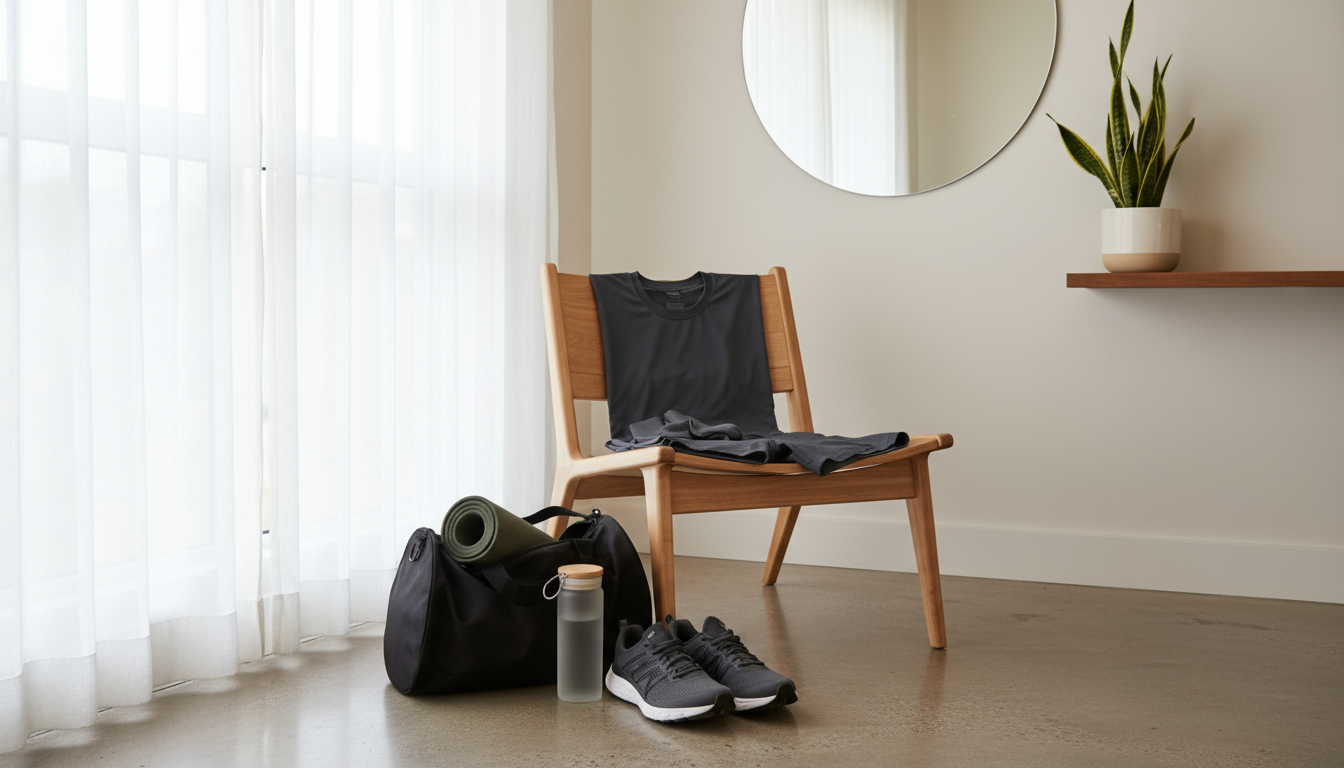
You’ve done it before. You’ve set a goal with a surge of motivation. Maybe it was to exercise every day, write a chapter of your book, or finally master meditation. The first few days, you were unstoppable. Your willpower felt like a superpower, easily pushing aside distractions and fatigue. But then, life happened. A long day at work, an unexpected errand, or just a simple dip in energy. Suddenly, that iron willpower felt more like a rusty gate, creaking under the slightest pressure.
If this sounds familiar, you are not alone. And more importantly, you are not a failure. The common narrative around goal achievement is built on a myth: the myth of heroic willpower. We’re told that to stay consistent, we just need to be tougher, more disciplined, and more motivated. But for most of us, especially those navigating the endless demands and distractions of modern urban life, relying on willpower is like trying to power a city with a single battery. It’s a finite resource that drains with every decision we make, every email we answer, and every traffic jam we endure.
The constant stream of notifications, opportunities, and obligations actively works against our long-term intentions. Your environment is practically designed to pull you off course. This is why the “try harder” approach so often leads to burnout, shame, and the frustrating cycle of starting and stopping. You end up feeling worse than when you began, convinced that something is wrong with you.
But what if there was a different way? A gentler, more strategic approach that doesn’t rely on superhuman effort? What if the secret, the simple trick to stay consistent, wasn’t about adding more force, but about removing friction? What if you could build durable habits that feel almost automatic, woven seamlessly into the fabric of your day?
This article will guide you through that very process. We’re going to set aside the myth of willpower and instead focus on a powerful, science-backed framework for building habits that last. It’s a method that works with your human nature, not against it. It’s about making your desired actions so small, so easy, and so obvious that consistency becomes the path of least resistance. Prepare to discover the simple, elegant trick to finally stay consistent with the goals that matter most to you.
📚 Table of Contents
- Understanding the Engine of Consistency: Your Brain’s Habit Loop
- Step 1: The Cue (The Trigger)
- Step 2: The Action (The Routine)
- Step 3: The Reward (The Payoff)
- The Missing Piece: Moving from Actions to Identity
- Design Your System for Inevitable Success
- 1. Start with a Minimum Viable Action (MVA)
- 2. Conduct a Friction Audit
- 3. Engineer Your Environment with Cues
- 4. Create Gentle Accountability
- Safeguards for the Real World: What to Do When You Slip
- Plan for Relapse: The “If-Then” Strategy
- Beware the “All-or-Nothing” Trap of Streak Psychology
- Practice Compassionate Resetting
- Putting It All Together: Two Worked Examples
- Frequently Asked Questions About Staying Consistent
- How long does it really take to form a new habit?
- What should I do on sick days or travel days when my routine is disrupted?
- I was doing great, but now I’ve hit a plateau. How do I stay motivated?
- Can I work on multiple new habits and goals at the same time?
- Your First Steps to Lasting Consistency

Understanding the Engine of Consistency: Your Brain’s Habit Loop
Before we can build better habits, we need to understand how they work. Pushing against a system you don’t understand is exhausting. But once you see the blueprint, you can work with it. The good news is that the core mechanism is surprisingly simple. Researchers at institutions like the National Institutes of Health (or NIH) have shown that our brains are incredibly efficient at automating frequent behaviors to save energy. This automation process is called the habit loop.
Think of it as a three-step neurological pattern that your brain runs on autopilot. Understanding these three parts is the first step in learning how to stay consistent with any new goal.

Step 1: The Cue (The Trigger)
The cue is the trigger that tells your brain to go into automatic mode and which habit to use. It’s the spark that ignites the behavior. Cues can be almost anything. Common categories include:
A time of day: Waking up in the morning, 3:00 PM when the afternoon slump hits.
A location: Your kitchen counter, your work desk, the driver’s seat of your car.
A preceding event: Finishing a meal, brushing your teeth, receiving a notification on your phone.
An emotional state: Feeling stressed, bored, anxious, or happy.
Other people: Seeing a coworker grab a coffee, your partner turning on the TV.
For example, the ping of your phone (cue) might trigger you to check social media. The sight of the coffee machine in the morning (cue) triggers you to brew a cup. These cues are often so subtle we don’t even notice them, yet they hold immense power over our actions.

Step 2: The Action (The Routine)
This is the behavior itself—the habit you perform. It’s the physical or mental action you take after the cue. It could be grabbing a cookie when you feel stressed, lacing up your running shoes when your alarm goes off, or opening your laptop to start working. This is the part of the loop we tend to focus on when we talk about goal setting and habits. We want to do the new thing. But the action doesn’t happen in a vacuum; it’s sandwiched between the trigger and the reward.

Step 3: The Reward (The Payoff)
The reward is the final, crucial step. It’s the positive outcome that tells your brain, “Hey, this loop was worth remembering for the future.” The reward satisfies the craving that the cue initiated. For the habit of checking your phone, the reward might be a momentary hit of social validation or a distraction from a difficult task. For the coffee habit, it’s the rich taste and the feeling of alertness. Without a satisfying reward, a behavior is unlikely to become an automatic habit. Your brain needs a reason to encode the pattern.
So, the loop is: Cue → Action → Reward. This cycle, repeated over and over, is what forges the strong neural pathways that turn a conscious effort into an unconscious habit.

The Missing Piece: Moving from Actions to Identity
Understanding the habit loop is a game-changer, but there’s one more layer that transforms good intentions into a durable lifestyle. It’s the shift from outcome-based goals to identity-based habits.
Most of us set goals based on what we want to achieve. For example: “I want to lose 20 pounds” (outcome) or “I want to write a novel” (outcome). There’s nothing inherently wrong with this, but it puts the focus on a distant finish line. The journey there can feel like a grind.
An identity-based approach flips the script. Instead of focusing on the outcome, you focus on who you wish to become. The question changes from “What do I want?” to “Who do I want to be?”
Instead of “I want to lose 20 pounds,” the identity is, “I am a healthy person who moves my body every day.” Instead of “I want to write a novel,” the identity is, “I am a writer.”
This might seem like a small semantic trick, but it’s incredibly powerful. Every time you perform a small action aligned with that identity, you cast a vote for the person you want to become. Each tiny workout is a vote for “I am a healthy person.” Each paragraph you write is a vote for “I am a writer.” The goal is not to run a marathon; the goal is to become a runner. The action is simply the evidence that proves your new identity to yourself. This internal shift provides a much deeper, more intrinsic form of motivation than chasing a fleeting outcome. It makes it easier to stay consistent because your actions are a reflection of who you are, not just a task on a to-do list.

Design Your System for Inevitable Success
If willpower is the unreliable employee, then your system is the dependable CEO. A well-designed system makes consistency feel less like a struggle and more like the natural, easy thing to do. This is where the real trick to stay consistent lies: not in trying harder, but in designing smarter. We’ll use four key principles to build a system that supports your goals automatically.

1. Start with a Minimum Viable Action (MVA)
The single biggest mistake people make when building a new habit is starting too big. Our initial burst of motivation tricks us into believing we can go from zero to one hundred overnight. But that motivation is a fickle friend. The key is to design a habit that you can stick with even on your worst day—when you’re tired, stressed, and have zero motivation.
This is the concept of the Minimum Viable Action (MVA). It’s the absolute smallest version of your desired habit, one that is so easy it feels almost ridiculous not to do it. The MVA should take two minutes or less to complete.
Let’s look at some examples:
Goal: “Read more.”
MVA: “Read one page of a book.”
Goal: “Meditate for 20 minutes daily.”
MVA: “Sit and take one deep breath.”
Goal: “Go to the gym three times a week.”
MVA: “Put on my running shoes and walk out the front door.”
Goal: “Write 1,000 words a day.”
MVA: “Open my document and write one sentence.”
The purpose of the MVA is not to get impressive results on day one. The purpose is to master the art of showing up. It builds the neural pathway for the action and solidifies your new identity. You are becoming the person who reads every day, the person who meditates, the person who exercises. Once the habit of showing up is established, you can naturally and gradually expand the behavior. But the foundation must be unshakably small.

2. Conduct a Friction Audit
Friction is anything that stands between you and your desired action. It’s the effort, time, or mental energy required to get started. Our brains are wired to conserve energy, so even a small amount of friction can be enough to derail our best intentions. The secret to how to stay consistent is to systematically decrease the friction for your good habits and increase it for your bad habits.
To do a friction audit, ask yourself: “What are all the steps between me and doing this habit, and how can I make them easier?”
Decreasing Friction for Good Habits:
Habit: Morning workout.
Friction: Finding clothes, packing a bag, deciding on the workout.
Solution: Lay out your workout clothes the night before. Pack your gym bag and put it by the door. Have a pre-selected workout routine ready to go.
Habit: Eating a healthy breakfast.
Friction: Prepping ingredients, cooking, cleaning up.
Solution: Prep overnight oats in a jar. Have pre-portioned smoothie packs in the freezer. Choose a simple option like Greek yogurt with berries.
Increasing Friction for Bad Habits:
Habit: Mindlessly scrolling on your phone at night.
Friction: The phone is right there on the nightstand.
Solution: Leave your phone to charge in another room overnight. Use an app that blocks social media after a certain time.
Habit: Eating junk food.
Friction: It’s easily accessible in the pantry.
Solution: Don’t buy it in the first place. Store any treats in an opaque container on a high shelf, making them invisible and hard to reach.
Spend 15 minutes auditing your environment. How can you make your desired path the path of least resistance? This small investment of time pays huge dividends in long-term consistency.

3. Engineer Your Environment with Cues
Your environment is one of the most powerful and invisible forces shaping your behavior. If your kitchen counter is covered in junk food, you’ll eat more junk food. If your guitar is in its case in the back of the closet, you’ll rarely practice. We must stop blaming ourselves for a lack of willpower and start taking responsibility for the spaces we inhabit. Design your environment to make your habit cues obvious.
This strategy is sometimes called habit stacking, where you link your new desired habit to an existing one that already serves as a reliable cue. The formula is: “After [Current Habit], I will [New Habit].”
For example:
“After I pour my morning cup of coffee, I will open my journal.” (The coffee pot is the cue).
“After I brush my teeth at night, I will do two minutes of stretching.” (The toothbrush is the cue).
You can also use physical objects as cues:
Want to drink more water? Place a water bottle on your desk, in your car, and on your nightstand.
Want to floss? Put the floss container directly on top of your toothpaste.
Want to take a daily vitamin? Put the bottle next to your coffee machine.
The goal is to make the cue for your good habit more obvious than the cues for your distractions. You are essentially programming your environment to give you a nudge in the right direction, reducing the need for conscious thought or motivation.

4. Create Gentle Accountability
While the internal shift to an identity-based approach is paramount, external support can be a powerful accelerator. Accountability adds a small, positive social pressure that encourages you to follow through.
This doesn’t have to be intense or judgmental. It can be as simple as having a “habit buddy.” Find a friend you can text each day after you’ve completed your MVA. “Did my one sentence!” or “Running shoes are on!” The act of reporting to someone else, even in a low-stakes way, makes you far more likely to do the thing.
Another form of accountability is simple tracking. A habit tracker, whether it’s a fancy app or a simple calendar with an “X” on the days you complete your habit, provides a visual representation of your progress. It leverages our desire not to “break the chain,” creating a rewarding feedback loop that reinforces the behavior. This visual proof is a powerful vote for your new identity.

Safeguards for the Real World: What to Do When You Slip
Perfection is not the goal. Life is messy and unpredictable. You will have days when you miss your habit. You’ll get sick, travel, or face an emergency. The difference between people who stay consistent long-term and those who don’t is not that they never fail; it’s how they respond to failure. Building safeguards into your system is essential for durable, shame-free goal setting.

Plan for Relapse: The “If-Then” Strategy
A misstep is not a moral failing; it is a data point. It gives you information about what went wrong and how you can adjust your system. One of the most effective ways to prepare for this is to create an “if-then” plan. You anticipate potential obstacles and decide, in advance, how you’ll respond.
The structure is simple: “If [Obstacle], then I will [Alternative Action].”
Example 1: Habit is a morning run.
If it’s raining heavily when I wake up, then I will do a 5-minute bodyweight routine in my living room.
Example 2: Habit is eating a healthy lunch.
If I have a last-minute lunch meeting at a restaurant, then I will look at the menu online beforehand and choose a salad or grilled protein option.
Example 3: Habit is writing for 15 minutes.
If I am completely exhausted after work, then I will open my document and just read over what I wrote yesterday.
By planning your response ahead of time, you remove the need for in-the-moment decision-making when your willpower is already low. You have a pre-made path to get back on track, preventing a small slip from turning into a complete slide.

Beware the “All-or-Nothing” Trap of Streak Psychology
Habit streaks can be incredibly motivating. Seeing a long chain of successes on your tracker feels great. However, they have a dangerous dark side: the “all-or-nothing” mindset. When you inevitably miss a day and the streak is broken, it can feel catastrophic. This single moment of imperfection can trigger a wave of shame and frustration, leading people to think, “Well, I’ve already ruined it. I might as well give up completely.”
This is where a simple but profound rule comes into play: Never miss twice.
One missed day is an accident. A second missed day is the beginning of a new, undesirable habit. This rule provides a clear, immediate action plan after a slip-up. Your single most important priority the day after you miss is to get back on track, no matter how small the action is. Even if all you can muster is your Minimum Viable Action, do it. This single act prevents the downward spiral of guilt and inaction. It reframes a mistake as a temporary blip rather than a total failure, which is crucial for long-term consistency.

Practice Compassionate Resetting
The internal voice we use when we stumble is critical. Many of us have a harsh inner critic that pipes up with “See? You can’t do it,” or “You’re just lazy.” This kind of self-talk is demotivating and counterproductive. Research in psychology, often supported by organizations like the American Psychological Association (APA), consistently shows that self-compassion is a far more effective motivator than self-criticism.
When you miss a day, treat yourself as you would a good friend who is struggling. Acknowledge that it was a tough day. Recognize that you are human. And then, gently guide yourself back to the plan. Your internal monologue should sound something like this:
“Okay, I didn’t get to it today, and that’s alright. Things were chaotic. The important thing is that I am the kind of person who gets back on track. Tomorrow, I will start again with my MVA. One small step is all I need.”
Resetting without shame is a skill. It requires you to separate your behavior from your identity. Missing one workout doesn’t make you a lazy person, just as eating one salad doesn’t make you a health guru. Your identity is built on the overall pattern of your behavior, and the most important part of that pattern is your commitment to returning to the path after a detour.

Putting It All Together: Two Worked Examples
Let’s see how these principles come together in real life. Here are two short, prose-based examples of routines designed for consistency, not intensity. Notice how they incorporate a cue, a Minimum Viable Action, friction reduction, and an identity-based focus.

Example 1: The Five-Minute Evening Wind-Down Routine
Sarah wanted to become the kind of person who was calm and prepared for the next day, rather than someone who frantically scrolled on her phone until her eyes burned. Her goal wasn’t just to “use her phone less,” but to embody a more intentional identity.
The Cue: She already had a strong, existing habit of brushing her teeth before bed. She decided to use this as her trigger. This is a classic example of habit stacking.
Reducing Friction: To make her new routine effortless, she created a “wind-down station” next to her bed. It held her journal, a pen, and the book she was reading. She also bought an old-fashioned alarm clock and started charging her phone in the kitchen overnight. This dramatically increased the friction of checking her phone in bed.
The Routine (Starting with the MVA): Her Minimum Viable Action was simple: “After I brush my teeth, I will sit on my bed and write one sentence in my journal about the day.” That was it. Just one sentence. On the first night, it felt almost silly, but she did it. On the second night, she wrote two sentences. Soon, she found herself naturally writing a short paragraph. After a week, she added another MVA: “After I write in my journal, I will read one page of my book.”
The Reward: The immediate reward was a feeling of accomplishment and a sense of calm. The long-term reward was waking up feeling more rested and less anxious. Each night she completed the tiny routine, she cast a vote for her new identity: “I am a calm and intentional person.” The routine now takes her about 10-15 minutes, but it started with an action that took less than 60 seconds.

Example 2: The Two-Minute Morning Focus Primer
Mark worked from home and struggled to start his workday. He’d often get his coffee and then lose 30 minutes to checking news sites and unimportant emails, derailing his focus before he even began. He wanted to become a focused, productive professional who owned his mornings.
The Cue: The most powerful and consistent cue in his morning was sitting down at his desk with his first cup of coffee.
Reducing Friction: Mark’s biggest friction point was the open-ended nature of “starting work.” To combat this, he adopted a simple rule the evening before: he would decide on his single most important task for the next day and write it on a sticky note. He then closed all unrelated tabs on his computer and opened only the document or program needed for that one task. He placed the sticky note on his monitor before logging off.
The Routine (Starting with the MVA): His MVA was: “After I sit down with my coffee, I will work on my most important task for just two minutes.” He set a timer. Anyone can do anything for two minutes. He wasn’t allowed to check email or news until after that two-minute block was complete.
The Reward: The magic of this approach is that starting is the hardest part. More often than not, at the end of the two minutes, he was already in a state of flow and just kept going. The immediate reward was a clear win before 9 AM. The long-term reward was a massive increase in productivity and a decrease in work-related anxiety. He was no longer just trying to be focused; he was actively proving to himself, every single morning, that he was a focused person.

Frequently Asked Questions About Staying Consistent
As you begin to apply these ideas, some practical questions will naturally arise. Here are answers to a few of the most common ones to help you navigate your journey.
How long does it really take to form a new habit?
You may have heard the popular myth that it takes 21 days to form a habit. The truth is more nuanced. That figure comes from a misinterpretation of a plastic surgeon’s observations about patients adapting to new faces. A more robust study published in the European Journal of Social Psychology found that, on average, it takes about 66 days for a new behavior to become automatic. However, the range in the study was huge—from 18 days to 254 days. The time it takes depends on the person, the behavior, and the environment. The key takeaway is to stop focusing on a magic number. Focus on the process. The real trick to stay consistent is to show up each day, no matter how small the action. The habit will become automatic when it becomes automatic.
What should I do on sick days or travel days when my routine is disrupted?
This is where the Minimum Viable Action truly shines. The goal on a disrupted day is not to perform your habit perfectly, but simply to keep the chain from breaking. If your habit is a 30-minute workout and you’re sick, your MVA might be just doing a few gentle stretches in bed. If your habit is to write 500 words and you’re on a travel day, your MVA could be to write a single sentence in a notes app on your phone. By scaling the habit down to its absolute smallest version, you maintain momentum and reinforce your identity even when circumstances are challenging. Remember the “never miss twice” rule. A tiny, imperfect action is infinitely better than doing nothing at all.
I was doing great, but now I’ve hit a plateau. How do I stay motivated?
Plateaus are a normal and expected part of any long-term journey. The initial excitement of a new habit wears off, and the progress may not be as rapid or visible as it was at the start. First, check in with your system. Is there new friction that has crept in? Can you make the cue more obvious? Second, reconnect with your identity. Remind yourself why you started this habit. Who are you trying to become? Sometimes, simply rereading your initial goals can reignite your purpose. Finally, consider introducing a small, novel variation to the routine to keep it fresh. If you’ve been running the same route, try a new one. If you’ve been meditating in silence, try a guided meditation. Don’t mistake a plateau for a dead end; it’s often just a sign that it’s time to adjust your course slightly.
Can I work on multiple new habits and goals at the same time?
While it’s tempting to overhaul your entire life at once, it’s generally a recipe for burnout. Your self-control and decision-making energy are finite. Trying to build several new, difficult habits simultaneously divides your focus and depletes your reserves, making you more likely to abandon all of them. A more effective strategy is to focus on one, maybe two, key habits at a time. Choose the “keystone habit” that you believe will create the biggest positive ripple effect in your life. For many, this is often related to exercise, sleep, or mindfulness. Once that first habit is firmly established and feels almost automatic, you can then use your newfound momentum and confidence to begin building the next one.

Your First Steps to Lasting Consistency
We’ve covered a lot of ground, from the inner workings of your brain to the practical design of your environment. But knowledge is only potential. The real transformation happens when you take action. The entire philosophy of this approach is to start small, so let’s honor that in how you begin.
The simple trick to stay consistent is not a single, magical hack. It’s a fundamental shift in approach: stop relying on willpower and start building a system that makes showing up the easiest choice. It’s about being a compassionate architect of your own behavior.
You don’t need to implement everything at once. Just choose one thing to begin. Here are a few clear, simple next actions you can take in the next 7 to 30 days to start building the foundation for durable habits and achieving your goals without burnout.
1. Choose One Goal and Define Your MVA. Pick a single, important goal you want to work on. Forget the grand vision for a moment and ask yourself: “What is the absolute smallest, two-minute version of this habit?” Define your Minimum Viable Action. Write it down. This is your only goal for the first week: to perform that tiny action every day.
2. Identify Your Cue. Where will this new, tiny habit fit into your existing day? Use the habit stacking formula: “After [Current Habit], I will [My MVA].” Be specific. “After I hang up my coat when I get home,” or “After the coffee finishes brewing.” This links your new intention to a concrete moment in time.
3. Do a 5-Minute Friction Audit. Look at your chosen MVA. What are the tiny barriers that might get in the way? What can you do right now to make it 1% easier? Can you lay out your book? Can you place your journal on your pillow? Can you create a shortcut on your computer? Take one small step to prepare your environment for success.
That’s it. That’s your starting point. Master the art of showing up. Cast that first, tiny vote for the person you want to become. Consistency is not born from a heroic leap; it is built from a thousand tiny, nearly invisible steps. Start with one.
Disclaimer: The information provided in this article is for informational purposes only and is not intended as a substitute for professional medical or psychological advice, diagnosis, or treatment. Always seek the advice of your physician or other qualified health provider with any questions you may have regarding a medical condition or mental health concern.






